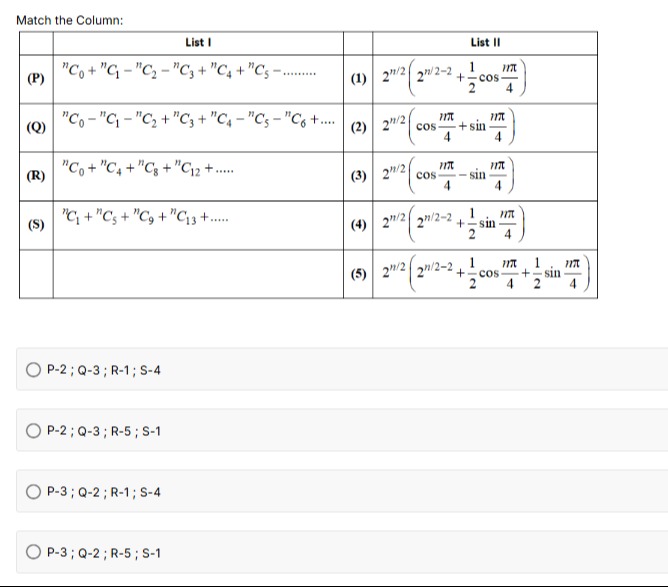Question
Question: Match the Column: | | List I ...
Match the Column:
| List I | List II | ||
|---|---|---|---|
| (P) | nC0+nC1−nC2−nC3+nC4+nC5−....... | (1) | 2n/2(2n/2−2+21cos4nπ) |
| (Q) | nC0−nC1−nC2+nC3+nC4−nC5−nC6+.... | (2) | 2n/2(cos4nπ+sin4nπ) |
| (R) | nC0+nC4+nC8+nC12+..... | (3) | 2n/2(cos4nπ−sin4nπ) |
| (S) | nC1+nC5+nC9+nC13+..... | (4) | 2n/2(2n/2−2+21sin4nπ) |
| (5) | 2n/2(2n/2−2+21cos4nπ+21sin4nπ) |

Option (2)
Option (3)
Option (1)
Option (4)
(P) → Option (2)
(Q) → Option (3)
(R) → Option (1)
(S) → Option (4)
Solution
We shall show that the four sums in List I can be written in closed‐form. (The idea is to use the roots of unity filter on the binomial expansion.) For example, define
S(j)=∑k≥0(4k+jn),j=0,1,2,3.
Then by the standard roots‐of‐unity technique
S(j)=41∑r=03ω−jr(1+ωr)n,with ω=i.
Now we match the sums as follows:
-
For (P):
The sum is nC0+nC1−nC2−nC3+nC4+nC5−⋯ which may be written as S0+S1−S2−S3. Working out the filter one finds that (P)=2n/2(cos4nπ+sin4nπ). This is exactly the expression given in Option (2). -
For (Q):
The sum nC0−nC1−nC2+nC3+nC4−nC5−nC6+⋯ equals S0−S1−S2+S3. A similar analysis gives (Q)=2n/2(cos4nπ−sin4nπ), which matches Option (3). -
For (R):
The sum nC0+nC4+nC8+⋯=S0, is obtained by the roots‐of‐unity filter: (R)=41[2n+2n/2+1cos4nπ]=2n−2+2n/2−1cos4nπ. Notice that writing 2n/2(2n/2−2+21cos4nπ)=2n−2+2n/2−1cos4nπ, we see that (R) is given in Option (1). -
For (S):
The sum nC1+nC5+nC9+⋯=S1, is worked out to be (S)=2n−2+2n/2−1sin4nπ=2n/2(2n/2−2+21sin4nπ), which is exactly Option (4).
Hence the correct matchings are:
- (P) → (2)
- (Q) → (3)
- (R) → (1)
- (S) → (4)
Minimal Explanation
- Write the given sums in terms of residue class sums Sj=∑k≥0(4k+jn) using the roots‐of‐unity filter.
- Express each sum (with the appropriate alternating signs) as a linear combination of S0,S1,S2,S3.
- Use (1+i)n=2n/2einπ/4 and (1−i)n=2n/2e−inπ/4 to simplify.
- Identify that (P) becomes 2n/2(cos(nπ/4)+sin(nπ/4)) [Option (2)], (Q) becomes 2n/2(cos(nπ/4)−sin(nπ/4)) [Option (3)], (R) becomes 2n/2(2n/2−2+21cos(nπ/4)) [Option (1)], and (S) becomes 2n/2(2n/2−2+21sin(nπ/4)) [Option (4)].
